
by EM2WL | Jun 30, 2014 | Building Muscle, Self Acceptance, The Journey
Perpetual diets often land us on a completely different path than expected. Many of us find ourselves on the frontline of Eating Disorder recovery, or fighting off the ED thoughts that a lifetime of dieting encourages. April shares a reflection of her mental journey with ED, an amazing encouragement for those still in the struggle.
 It’s been about two years since I met Kiki and Lucia and the EM2WL society. Two years since I started really listening to the advice given to me. Two years since I started fighting the false need to restrict and purge, two years since I threw out the 100-calorie meals and traded them in for what my body really needed, two years since I put down the baby weights and picked up a barbell.
It’s been about two years since I met Kiki and Lucia and the EM2WL society. Two years since I started really listening to the advice given to me. Two years since I started fighting the false need to restrict and purge, two years since I threw out the 100-calorie meals and traded them in for what my body really needed, two years since I put down the baby weights and picked up a barbell.
It hasn’t been easy.
The summer of 2012 is when it all began, and I remember it so well. With the encouragement of EM2WL, I’d started to eat a bit more, quite a bit more, and lifting just prior to our summer vacation in Canada. I was still working out like a maniac, getting up at 5am for cardio and then following it up with weights after work. The idea of going to a foreign country without any specific workout schedule was debilitating. The weeks leading up to vacation, I had mini panic attacks that only slowed to a mild fear once my friend secured me a 3-day pass to the Y for our visit.
Also during those weeks, I started to bloat. The extra calories I was consuming (and needed) were throwing my poor body out of whack. My metabolism was such a mess from years of underfeeding it that my body had no choice but to bloat up. My children’s size 12 jean leggings were starting to get too tight, but I shoved myself into them during that vacation. I still fit into my double zero shorts, but barely, and I could see the bloat. I didn’t help matters by drinking a lot of wine that week and staying up late after everyone went to bed to binge on “healthy” snacks I’d brought with us. They were calories I needed, but I ate most of my calories all at once late at night along with a glass of wine. I was so tempted to purge, but I couldn’t since it wasn’t our house, and it was a small house. I would have been heard. I’d never felt so fat.
 Once we got home, we had a few weeks before our next vacation – a long weekend on Chincoteague Island. I spent the time detoxing and getting back into my workouts, and I started to feel a bit better. My body was still bloated, and I bought children’s size 14 jean leggings, but for the most part, I still thought I could fit into my double zeros forever. I was determined to do so. Somehow, despite the recent bloating, the four days on the Island were the last days I ever felt “skinny.”
Once we got home, we had a few weeks before our next vacation – a long weekend on Chincoteague Island. I spent the time detoxing and getting back into my workouts, and I started to feel a bit better. My body was still bloated, and I bought children’s size 14 jean leggings, but for the most part, I still thought I could fit into my double zeros forever. I was determined to do so. Somehow, despite the recent bloating, the four days on the Island were the last days I ever felt “skinny.”
Then we came home, and I started the New Rules of Lifting for Women. Now I REALLY gained weight. I still ate more and lifted heavy, and I was forced to face facts: I would have to buy new clothes.
Over the next year or so, I pretty much hated myself. I’d spend nights binging and sometimes purging. I stuffed my body into clothes that were too tight, praying for my weight to drop. I played with the idea of restricting again, and occasionally, I gave in. Sometimes I changed my mind about lifting and went back to cardio, but nothing changed. Throughout it all, Kiki and Lucia and a handful of others stuck around. They listened to my complaints and encouraged me to keep pushing forward. They filled my head with more and more knowledge about how to eat and what was happening to my body and why lifting is so important.
Eventually, I bought clothes that fit and started to feel marginally better. Gradually, I learned what kinds of workouts my body could handle without destroying my mental state. I finally stopped killing myself with 2 workouts/day and limited most of my cardio to HIIT (albeit LONG HIIT) and hid my scale away which made a HUGE difference in the way I felt about my body.
 I can’t pinpoint the exact date or even the exact month, but at some point during 2013, my metabolism evened out. The bloating disappeared. I was still heavier and larger than I’d been during most of my late 20s, but I started to have “sleek” days. I started to enjoy lifting and to rejoice over the NSVs.
I can’t pinpoint the exact date or even the exact month, but at some point during 2013, my metabolism evened out. The bloating disappeared. I was still heavier and larger than I’d been during most of my late 20s, but I started to have “sleek” days. I started to enjoy lifting and to rejoice over the NSVs.
I can confidently say that 2014 has been the best year of my life in all the ways that matter. I’m learning about lifting phases and how to plan my workout rotations to keep my body guessing. I no longer stress my body with long HIIT or steady state sessions which means more time with my family. I FINALLY allow my body 2 days of rest each week, and to my surprise, that small change filled me with such relief! It was as though I was finally giving myself permission to sit back and enjoy those weekends without the stress of choosing a workout and trying to burn calories. Most days, I feel great!
I still stress sometimes over calories numbers – calories burned during workouts and calories consumed. I still have my “yuck” days, and I am still TERRIFIED to take a full rest week during vacation this year!
But I’ve learned so much over these past two years and come so far, it’s hard to believe I’m the same person. I no longer look at the pictures of myself when I was 90 pounds and yearn to be that small anymore. I’ve thrown out all of my double zeros and don’t even care what the number on the tags are when I go shopping for new clothes. I have everything from small to large, from 4 to 9, and I just don’t care anymore so long as it fits well and looks good. I’m more confident than I’ve ever been. I’m talking my entire life. I still have the parts of me I’d like to make better, but for the most part, I’ve given up the comparison to other women and the self-name-calling. I’ve given up looking at myself every day and walking away “knowing” I am fat. Because I’m not. Because I’m strong and fit and healthy and beautiful. I don’t feel that every day, but I almost never hate myself.
I could never have gotten here without all of you. Never. Thank you all so much for your love and support, for encouraging me through this journey rather than giving up on me. Here’s to the journey, no matter how tough. The end is nowhere in sight, but possibilities are endless.

Strong and fit!
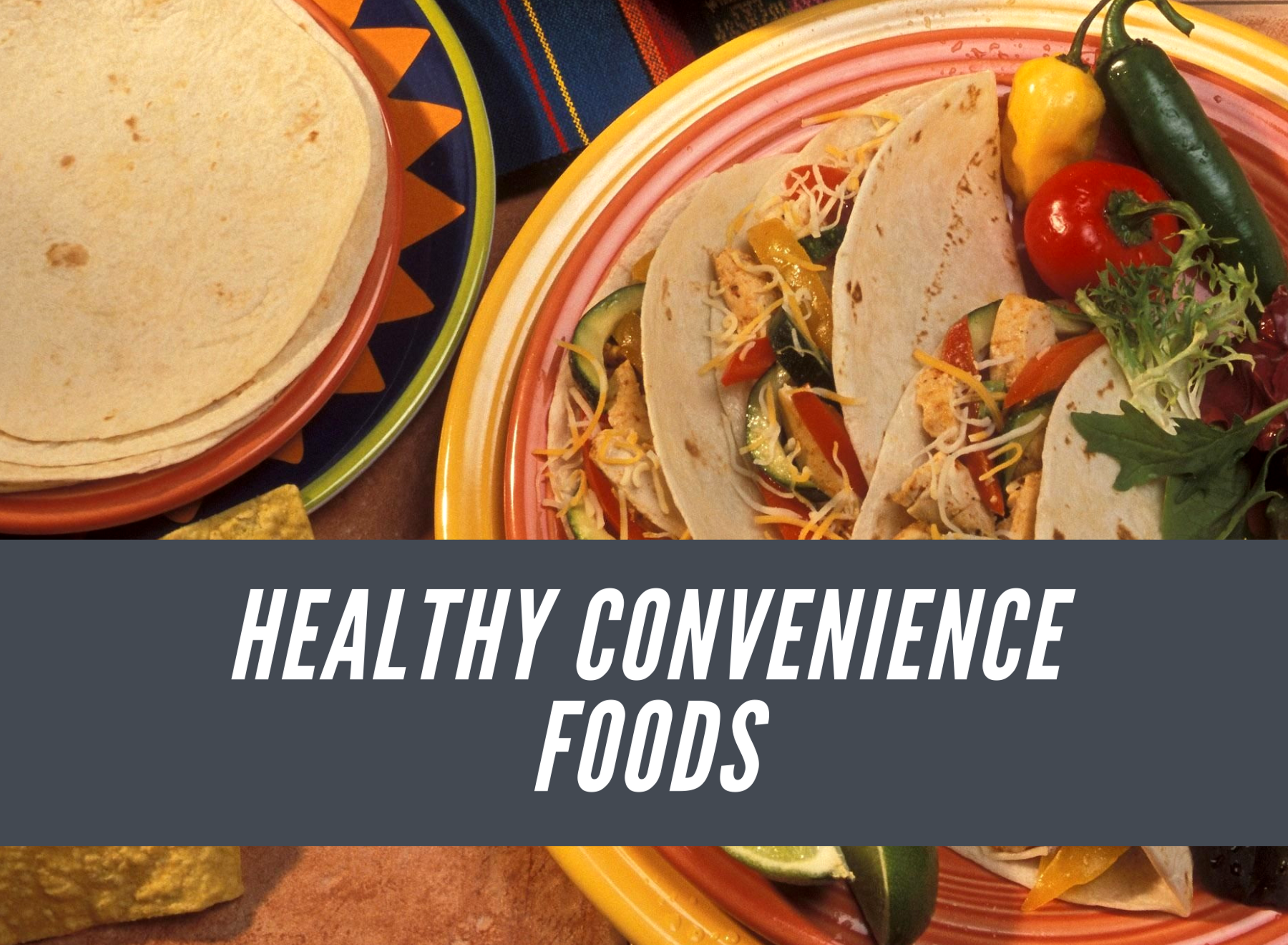
by Trish Adams | Jun 24, 2014 | Nutrition, Stress
It seems like each year moves quicker than the last. There is never enough time to get all the things done on our task list. Each day runs into the next, and if we aren’t careful, our nutrition takes a back seat to convenience. That’s where healthy convenience foods come in handy.
I experienced this firsthand over the past year when work stress was at an all-time high. I was mostly concerned with just getting enough sleep. My nutrition stayed intact by focusing on eating foods that didn’t require much time, effort or thought, but were still nutritionally balanced.
 When you think of convenience food you may conjure up images of Hungry Man or fast food restaurants like McDonald’s. Thankfully, there are way better options available if you keep a go to list and put in just a smidgen of effort.
When you think of convenience food you may conjure up images of Hungry Man or fast food restaurants like McDonald’s. Thankfully, there are way better options available if you keep a go to list and put in just a smidgen of effort.
My definition of a healthy yet still convenient meal is one that requires minimal effort to prepare, can be assembled in 15 minutes or less and is nutritionally dense and balanced. Although it may require a little bit of energy to assemble, it won’t require any special cooking skills or even a measuring cup! If I can’t spare 15 minutes out of my day then I have to rethink what I’m doing.
All convenience foods aren’t created equal and some things to be on the lookout for are foods that are high in sodium, sugar, fat or all three! Many frozen foods that are fully prepared like Hungry Man or foods cooked in a sauce are often offenders. Assembling your own food will help you avoid the high sodium-sugar-fat trap.
Let’s get…assembling!
 A great place to start is with your protein. I like to think of protein as the super star of the meal and work everything else around it. Nowadays, there are so many pre-cooked protein options that you can really set up a great rotation. Rotisserie chicken , grilled chicken (refrigerated or frozen) or fish (fresh or canned i.e. tuna, sardines, wild salmon) are just a few options.
A great place to start is with your protein. I like to think of protein as the super star of the meal and work everything else around it. Nowadays, there are so many pre-cooked protein options that you can really set up a great rotation. Rotisserie chicken , grilled chicken (refrigerated or frozen) or fish (fresh or canned i.e. tuna, sardines, wild salmon) are just a few options.
Likewise, there are many pre-cooked carb options available – frozen, refrigerated or canned. A few to consider are quinoa, rice varieties including brown, white, jasmine and more, lentils, canned beans. With these options it’s just a matter of heat and serve.
When it comes to veggies, the options are seemingly endless. You can buy them fresh, frozen or canned. For even more convenience, buy them pre-washed, pre-sliced or pre-chopped. You can find them stand alone or as part of a medley. You can even find them in microwavable bags where you only need pop them directly in the microwave for 5-10 mins and then plate them. The point is, when it comes to veggies, skipping out on them for the sake of convenience is hogwash. Keeping dishes flavorful, however, is key, so consider picking up seasons such as garlic salt, lemon pepper or Cajun to keep your taste buds happy.
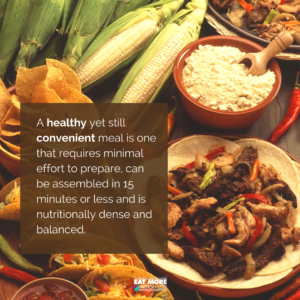 Of all the convenience foods, fats are the most readily available. Adding a tablespoon or two of your favorite oil to your foods or sauteing veggies in a pat of butter is a no-brainer. Same thing for avocado, just cut and scoop! Eating a fatty fish rich in Omega-3 like salmon will serve double duty, providing both protein and fat for your meal.
Of all the convenience foods, fats are the most readily available. Adding a tablespoon or two of your favorite oil to your foods or sauteing veggies in a pat of butter is a no-brainer. Same thing for avocado, just cut and scoop! Eating a fatty fish rich in Omega-3 like salmon will serve double duty, providing both protein and fat for your meal.
To keep things less stressful, be sure to keep some of these foods on hand to make answering the question of “What’s for dinner?” a breeze.
Putting it altogether
Now that you have a few ideas of some convenient staples, here are a few ideas on how to put together a meal.
- Rotisserie chicken, skinned & chopped + jasmine rice + broccoli slaw + dressing
- TJs Lightly seasoned chicken breast + lentils + asparagus
- Tuna + broccoli + avocado toss
- Broiled tilapia (10 min) + vegetable medley + low sodium butternut squash soup
- Broiled salmon (10 min) + mango salsa + green peas + brown rice
- Tacos – browned ground turkey (10 min) + salad + avocado
- Eggs/onion/mushroom/spinach scramble + Ezekiel bread + almond butter
- Rotisserie chicken, skinned & chopped + broccoli slaw + wrap + dressing
- Baby spinach + chopped grilled chicken + sliced peppers + quinoa + olive oil + balsamic vinegar
There are so many options that you can create with a few staple ingredients. Just mix things up or change out the seasonings. With all of the options available to you, it’s possible to have a new meal every day for a month if you wanted to.
You don’t have to sacrifice your nutrition for convenience and you don’t need to be a star cook. With slightly more effort than it takes to warm up a hungry man, you can have a meal that takes less time and is more nutritious! Many meals will make 2-4 servings, so you’ll only need to re-heat them the next day. One less meal to worry about!

by EM2WL | Jun 5, 2014 | Building Muscle, Cardio, Fat Loss / Cutting, Nutrition
Q: I’ve been lifting for about a year. I love my time at the bar, but I’m frustrated by my lack of progress! I see my training partner’s lifts going up consistently, but I can’t seem to push past plateaus! What am I doing wrong?
A: There are a number of possible explanations why you may have hit a plateau with your lifts. Be aware that almost everyone reaches a point where their lifts have stalled, but usually, when your lifts have stalled it is a good sign to look at your programming and determine if a small tweak or two could help.
It’s also important to remember that those new to lifting will make very quick progress regardless of what program they are following. After a few years of lifting however, it’s important to pay closer attention to the details.
Below are a few of the reasons why your lifting may have stalled.
1. Trying to lose fat (cals/carbs too low)
After you get past the stage of newbie gains, it is very difficult to gain strength while in a caloric deficit. You will probably find that you are able to consistently increase strength, gain muscle and lose fat (albeit very slowly) eating closer to your maintenance level calories. This isn’t to say that it can’t be done, but you will probably want to pay very close attention to nutrient timing, making sure to take in plenty of carbohydrates pre- and post-workout.
When trying to lose fat, many tend to view carbs as “optional.” However, if you are desiring to increase strength, cutting out carbs is not the wisest idea. Carbohydrates are your body’s preferred source of energy for intense workouts. Furthermore, when carbohydrates are adequate in the diet, it spares protein from being used for energy, and protein can do its job-build and repair muscle tissue.
When starting a cut, it’s best to decrease carbohydrates and calories very slowly, keeping an eye on your training and the way that you feel and tweaking things accordingly. If you are consistently feeling very run down and missing lifts in the gym, you may want to consider increasing your carbohydrates and possibly cutting back on the amount of fat that you are taking in.
Generally, slow-acting carbohydrates(sweet potatoes, whole grains, and low-glycemic fruits) are best consumed about 30 minutes to an hour prior to your strength training session. This will provide enough time for digestion so that you don’t go into your workout feeling overstuffed. Fast-acting carbohydrates (white potatoes or rice, foods high in sugar, or high-glycemic fruits) are best taken in during the hour after training.
Following an intense strength training session, your cells are depleted of both glucose and glycogen. Cortisol levels are also elevated. Fast-acting carbohydrates cause an increase in insulin levels, which in turn can cause greater muscle growth, when timed appropriately. When consumed, simple carbohydrates can be stored as glycogen, which is the primary source of muscle “fuel” during intense training sessions.
Post workout, elevated insulin levels allow muscle to better utilize stored glycogen for recovery and growth. This also helps cortisol levels to return to normal levels following an intense training session.
Don’t fear carbs, but learn how to use them to complement your training!
2. Too much emphasis on endurance activities
Another common mistake that strength trainers, especially women, make is of doing too many reps, too much cardio, and too many exercises that fatigue the smaller muscle groups. If your primary goal is to gain strength, you will want to keep your reps low and your weights high (3-5 reps at 80-85%1RM) on compound movements. Always do your compound movements (squat, bench, deadlift, rows, and presses) first, and use assistance work as needed to bring up weak points and provide an environment for hypertrophy. Assistance work should still be kept in the range of 8-12 reps for 3-5 sets. If you are able to do more than 12 reps, it is probably a good idea to increase the weight.
Cardio is a question that tends to come up frequently. A lot of women are okay with incorporating some strength training into their workout rotation, but panic at the thought of cutting back on or eliminating cardio. However, if your primary goal is to increase strength, too many endurance activities (i.e., steady-state cardio) can detract from the strength gains you are wanting to see.
If you still want to include some cardiovascular training into your workout rotation, the best scenario would be to add in some short (4-12 minute) metabolic finishers at the end of your strength training sessions. A metabolic finisher is an intense exercise or circuit of exercises designed to increase your body’s fat-burning potential by increasing the “afterburn effect” by increasing the number of calories burned as you recover from your workout. It speeds recovery by returning blood flow to the muscles and improving all-0ver conditioning and athleticism.
Good options for metabolic finishers include heavy kettlebell swings, tire flips, various forms of weighted carries, barbell complexes, sprints, prowler/sled work, and body weight exercises.
3. It’s all in your head
Sometimes, we are our own worst enemy to making progress. If you’re going for a PR, there should be no question in your mind that you will finish the lift. If you approach PR attempts with a fear of failing or a less than confident approach, chances are you will hinder any forward progress.
When you are going for a PR attempt, you must be completely confident as you approach the bar. Training with good spotters that you trust is crucial as you train with very heavy weights, especially as you go for lifts that are near 100% 1RM. There is a time and place for training to failure, but generally speaking, you will always want to end your training session successfully.
If you have any doubt in your mind that you won’t finish a lift, save it for another day.
4. Under- recovery between sets/training sessions
Another common mistake is failing to recover adequately, either in between sets or in between training sessions. It’s critical that the length of your rest periods lines up with your goals. Since it requires about 3 minutes for phosphagen stores to be replenished, 3 minute rest periods are probably most optimal if you are training for pure strength.
Full recovery will allow you to generate the most muscular power for each set, making each set as effective as possible. If you are training for pure strength, slow down in between sets, sip water, and get mentally refocused before beginning your next set.
Make sure that you are taking adequate time between training sessions to recover as well. A good rule of thumb is to take about 48 hours recovery in between intense training sessions. However, you can train opposing body parts on consecutive days (upper body on Monday, lower body Tuesday, rest Wednesday, upper body Thursday, lower body Friday). Make sure that your rest days are truly restful.
In addition, you will want to make sure that you are taking in plenty of high quality food, sleeping well, and keeping stress levels as low as possible to maximize your recovery time!
5. Attempting too much, too soon
It’s important to make sure that the strength goals that you have outlined for yourself are reasonable. Attempting to increase too much weight too soon will most likely result in injury, frustration, and breakdown in form.
Choose a solid, periodized program and determine to stick with it and trust the process! Training with sub-maximal weights will get you stronger over time. On a similar note, testing training maxes too often is extremely taxing on your CNS and will make recovery in between training sessions much more difficult. Focus instead on setting rep PRs, and leave training maxes to once every 4 weeks, at most.
Generally speaking, a reasonable expectation would be to see lower body lifts increase by about 10-20 pounds and upper body lifts increase by about 5-10 pounds over a 8-12 week period of time, provided you are being consistent in your training and paying attention to your nutrition. It may not seem like much, but over time, you will be amazed at your progress if you can learn to be patient with small strength gains.
6. Same old, same old
Our bodies are very good at making adaptations to the stressors that we place upon it. In order to continue to make progress, it is important to switch things up every once in awhile.
If you’re stuck at a strength plateau and have been following the same program or rep scheme for over 12 weeks, it is probably a good idea to switch things up. If you’re used to training in the 8-12 rep range, you may switch to a 5 x 5 for awhile and work on increasing your weights. If you’ve been training with heavy weights and low reps for awhile, you may benefit from an increase in volume. Varying your assistance work is an other great way to keep your body challenged!
However, a word of caution: make sure to change one or two things at a time and stick it out for a minimum of 8-12 weeks before changing another factor. It’s very important to make small changes and make careful notes about what is working. If you change too many things at once, you will never know what’s working!
7. Bad technique
Take the time to learn proper form, especially on the three big lifts (bench, squat, and deadlift). Always train to a full range of motion, and you will get the maximum benefit from each rep and set. If you are unsure about proper form on these lifts, you might benefit greatly from setting up an appointment to meet with a personal trainer, or watching instructional videos on Youtube. Start with the empty bar and be patient with yourself. Once you learn proper technique, it will become easier and easier to add weight to that bar and see the strength gains you desire!
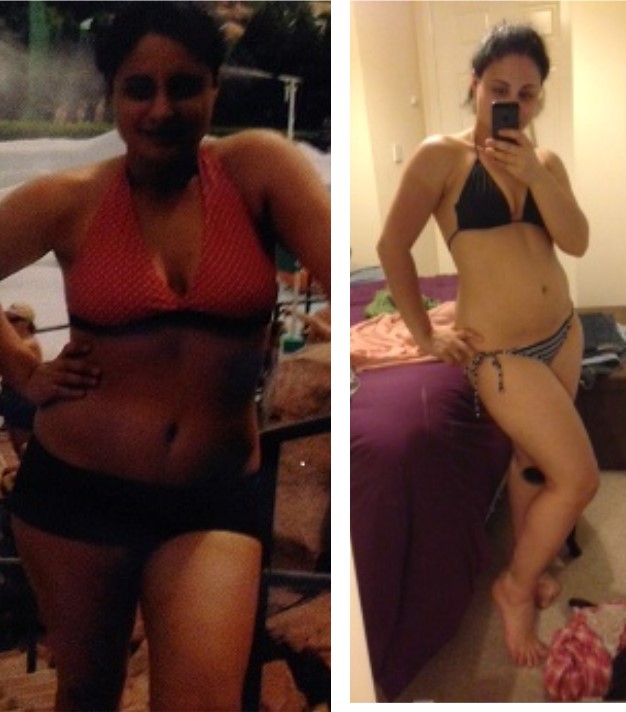
by | Jun 3, 2014 | Consistency, Increasing calories, Testimonials, Transformations
 I have been on this journey for about five months now, at the beginning I’ve got to admit whilst the science made sense I was skeptical. I kept thinking well if it’s that easy why isn’t everyone else doing it. I had already come to the conclusion that these low calorie diets were doing more harm than good, had already experienced that first hand. I didn’t want another holiday to go by where I would be vetting the photos before showing anyone to take out the horrible, fat ones. I figured ‘why not’ there’s months til my holiday I’ll give it a go.
I have been on this journey for about five months now, at the beginning I’ve got to admit whilst the science made sense I was skeptical. I kept thinking well if it’s that easy why isn’t everyone else doing it. I had already come to the conclusion that these low calorie diets were doing more harm than good, had already experienced that first hand. I didn’t want another holiday to go by where I would be vetting the photos before showing anyone to take out the horrible, fat ones. I figured ‘why not’ there’s months til my holiday I’ll give it a go.
I’m not going to say that the journey has been easy, I have had to deal with some pretty big mental issues. It’s extremely hard to get your head around the fact that you really can eat more (in my case a lot more and still lose weight) and also learn to deal and how to cope when the scale doesn’t do what it’s supposed to. But I persevered believing that the hardship and the stress would be worth it in the end. So I continued to eat more, continued to lift heavy weights, and now also added in running. It no longer was a hardship, somehow along the way it became ‘normal’ and I stopped fretting about the scale and stopped fretting about going slightly over my allowance.
 I log my intake on a regular basis, and do keep an eye on my weight, but I really feel as though for the first time in a long time, my weight has taken a back seat. I feel as though I am just living my life, without worrying about what I’m eating all the time. I can’t pretend I’m there yet, I still have several inches of fat that I have to lose before I can say I have finished cutting. But I wouldn’t have gotten to this point if someone hadn’t sent me the link to the group one day – this is why I feel that the Eat More to Weigh Less lifestyle (because it shouldn’t be viewed as a quick fix diet!) should be shouted from the rooftops!!!
I log my intake on a regular basis, and do keep an eye on my weight, but I really feel as though for the first time in a long time, my weight has taken a back seat. I feel as though I am just living my life, without worrying about what I’m eating all the time. I can’t pretend I’m there yet, I still have several inches of fat that I have to lose before I can say I have finished cutting. But I wouldn’t have gotten to this point if someone hadn’t sent me the link to the group one day – this is why I feel that the Eat More to Weigh Less lifestyle (because it shouldn’t be viewed as a quick fix diet!) should be shouted from the rooftops!!!
I am obviously delighted that I have lost weight and inches, but I really feel that my favourite benefit is feeling as though I have control over my eating. I don’t binge, then feel guilty and wanting to starve myself. I don’t feel as though there are things that are out of reach or feel as though I have to restrict my eating of certain things.
 It sounds crazy, but I am seriously happily living my life, I don’t think I even really think about food like I did before, where I was constantly thinking about what I was going to eat next, is everyone going to think I’m a pig if I have another chocolate or biscuit. Now I literally eat what I want and move on, and it’s AWESOME!!!!!!!
It sounds crazy, but I am seriously happily living my life, I don’t think I even really think about food like I did before, where I was constantly thinking about what I was going to eat next, is everyone going to think I’m a pig if I have another chocolate or biscuit. Now I literally eat what I want and move on, and it’s AWESOME!!!!!!!
So, I feel like I’m here to stay the course, I have totally turned my life around, and am eating loads and exercising loads (and really enjoying it). I have found that I have started to inspire more people around me, now they can see my results, so hopefully they will also abandon these crazy 1,000 calories diets in favour of listening to what their body wants. Everyone should know that there is no need to starve themselves, there is another healthier way of doing this.

 It’s been about two years since I met Kiki and Lucia and the EM2WL society. Two years since I started really listening to the advice given to me. Two years since I started fighting the false need to restrict and purge, two years since I threw out the 100-calorie meals and traded them in for what my body really needed, two years since I put down the baby weights and picked up a barbell.
It’s been about two years since I met Kiki and Lucia and the EM2WL society. Two years since I started really listening to the advice given to me. Two years since I started fighting the false need to restrict and purge, two years since I threw out the 100-calorie meals and traded them in for what my body really needed, two years since I put down the baby weights and picked up a barbell. Once we got home, we had a few weeks before our next vacation – a long weekend on Chincoteague Island. I spent the time detoxing and getting back into my workouts, and I started to feel a bit better. My body was still bloated, and I bought children’s size 14 jean leggings, but for the most part, I still thought I could fit into my double zeros forever. I was determined to do so. Somehow, despite the recent bloating, the four days on the Island were the last days I ever felt “skinny.”
Once we got home, we had a few weeks before our next vacation – a long weekend on Chincoteague Island. I spent the time detoxing and getting back into my workouts, and I started to feel a bit better. My body was still bloated, and I bought children’s size 14 jean leggings, but for the most part, I still thought I could fit into my double zeros forever. I was determined to do so. Somehow, despite the recent bloating, the four days on the Island were the last days I ever felt “skinny.” I can’t pinpoint the exact date or even the exact month, but at some point during 2013, my metabolism evened out. The bloating disappeared. I was still heavier and larger than I’d been during most of my late 20s, but I started to have “sleek” days. I started to enjoy lifting and to rejoice over the NSVs.
I can’t pinpoint the exact date or even the exact month, but at some point during 2013, my metabolism evened out. The bloating disappeared. I was still heavier and larger than I’d been during most of my late 20s, but I started to have “sleek” days. I started to enjoy lifting and to rejoice over the NSVs.

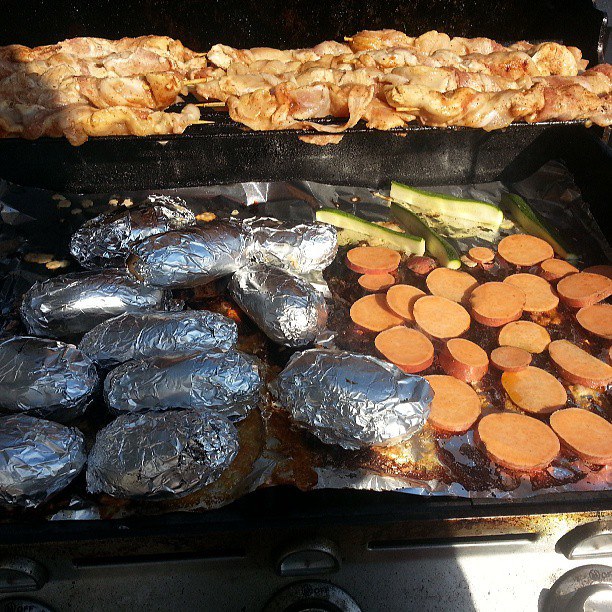
 Print recipe
Print recipe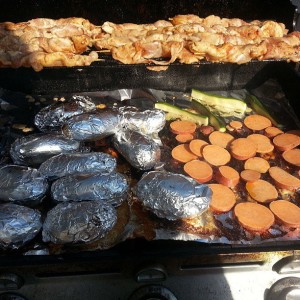

 When you think of convenience food you may conjure up images of Hungry Man or fast food restaurants like McDonald’s. Thankfully, there are way better options available if you keep a go to list and put in just a smidgen of effort.
When you think of convenience food you may conjure up images of Hungry Man or fast food restaurants like McDonald’s. Thankfully, there are way better options available if you keep a go to list and put in just a smidgen of effort. A great place to start is with your
A great place to start is with your  Of all the convenience foods, fats are the most readily available. Adding a tablespoon or two of your favorite oil to your foods or sauteing veggies in a pat of butter is a no-brainer. Same thing for avocado, just cut and scoop! Eating a fatty fish rich in Omega-3 like salmon will serve double duty, providing both protein and fat for your meal.
Of all the convenience foods, fats are the most readily available. Adding a tablespoon or two of your favorite oil to your foods or sauteing veggies in a pat of butter is a no-brainer. Same thing for avocado, just cut and scoop! Eating a fatty fish rich in Omega-3 like salmon will serve double duty, providing both protein and fat for your meal.




Recent Comments